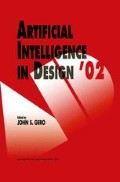Abstract
It is acknowledged that the design requirement capture phase of design is an important one, and that failures in this phase of the design often occur to the detriment of the end product. Thus assisting designers in this phase of design is useful. Elicitation of the design requirement from the customer (however defined) and evolving and translating it into a representation appropriate for driving design is a knowledge-intensive activity. In particular, both the customer and the designer must have knowledge of the domain in which they are working, and have overlapping sets of this knowledge. Without this overlap communication would be impossible. Similarly, in order to develop computerized designer support systems for this phase of the conceptual design process, it is necessary that the knowledge brought to this process by the human practitioners be shared between the human user and the computer. This is essential if meaningful communication and inference is to take place. This paper considers the basis for knowledge sharing and communication, and how knowledge ‘contexts’ provide the foundation for mutual understanding. This model is used to suggest a mechanism by which incomplete domain knowledge can be identified and embodied. The domain knowledge can then be applied so that communication between human and machine can be enhanced to provide design support in the design requirement elicitation process.
Access this chapter
Tax calculation will be finalised at checkout
Purchases are for personal use only
Preview
Unable to display preview. Download preview PDF.
References
APTICOTE-ISIS Surface Engineering Selection Expert System,URL:http://www.poeton.co.uk/fr-pands.htm
Bath Engineering Design Group: 2001, Design Requirements Guidelines, Department of Mechanical Engineering, University of Bath.
Cross, N: 2001, Can a machine design? Design Issues 17: 44–50.
Darlington, M J and Potter, SE: 1998, Engineering design requirements formalization: the development of a constrained natural language and an elicitation scheme formalizing aspects of the design requirement, Internal Report No. 041/98, Engineering Design Centre in Fluid Power Systems, University of Bath.
Darlington, M, Culley, SJ and Potter, S: 2001, Using domain knowledge to support design requirements elicitation, in S Culley, A Duffy, C McMahon and K Wallace (eds), Proceedings of 13th International Conference on Engineering Design (ICED 01), Professional Engineering Publishing, Edmunds, pp. 83–90.
Durney, LJ: 1984, Electroplating Engineering Handbook, 4 11 ’ Edition, Chapman Hall, London.
Edmonds, B: 1997, A simple-minded network model with context-like objects, Proceedings European Conference on Cognitive Science, Department of Computer Science, University of Manchester, Manchester, pp. 180–184. http://www.cpm.mmu.ac.uk/cpmrepI5.html
Gabe, DR: 1972, Principles of Metal Surface Treatment and Protection, Pergamon Press, Oxford.
Genesereth, MR and Nilsson, NJ: 1987, Logical Foundations of Artificial Intelligence, Morgan Kaufmann, San Mateo, CA.
Gruber, T: 1993, A translation approach to portable ontologies, Knowledge Acquisition 5 (2): 199–220.
Hales, C: 1993, Managing Engineering Design, Longman Scientific and Technical, Harlow.
Lenat, D: 1998, The Dimensions of Context-Space,Cycorp. URL:http://www.cyc.com/publications.html
Miller, GA, Beckwith, R, Fellbaum, C, Gross, D and Miller, KJ: 1990, Introduction to WordNet: an on-line lexical database, International Journal of Lexicography 3(4): 235–244. ftp://ftp.cogsci.princeton.edu/pub/wordnet/5papers.ps.
Noy, N and McGuinness, DL: 2000, Ontology Development 101: A Guide to Creating your First Ontology,Stanford Medical Informatics Technical Report No. SMI-2001–0880. URL: http://smi-web.stanford.edu/pubs/SMI_Abstracts/SMI-2001-0880.html
Ogden, CK and Richards, IA: 1923, The Meaning of Meaning, Harcourt, Brace and World, New York.
Pahl, G and Beitz, W: 1996, Engineering Design — A Systematic Approach, 2nd Edition, Springer-Verlag, London.
Protégé: 2000, Ontology Editor and Knowledge Acquisition Tool,URL: http://protege.stanford.edu/index.shtml.
Pugh, S: 1991, Total Design: Integrated Methods for Successful Product Engineering, Addison-Wesley, Wokingham.
Stillings, NA, Feinstein, MH, Garfield, JL, Rissland, EL, Chase. CH, Weisler, SE and Rissland, EL: 1995, Cognitive Science: An Introduction, 2“ d Edition, MIT Press, Cambridge, MA.
Ullman, DG: 1997, The Mechanical Design Process, 2nd Edition, McGraw-Hill, NY.
Ulrich, KT. and Eppinger, SD: 1995, Product Design and Development, McGraw-Hill, New York.
Wootton, AB, Cooper, R and Bruce, M: 1997, Requirements capture: where the front end begins, in A Riitahuhta (ed.), Proceedings of 11“ Int. Conference on Engineering Design (ICED 97). Tampere University of Technology, pp. 75–80.
Author information
Authors and Affiliations
Editor information
Editors and Affiliations
Rights and permissions
Copyright information
© 2002 Springer Science+Business Media Dordrecht
About this chapter
Cite this chapter
Darlington, M., Culley, S.J. (2002). Elucidating the Design Requirement for Conventional and Automated Conceptual Design. In: Gero, J.S. (eds) Artificial Intelligence in Design ’02. Springer, Dordrecht. https://doi.org/10.1007/978-94-017-0795-4_21
Download citation
DOI: https://doi.org/10.1007/978-94-017-0795-4_21
Publisher Name: Springer, Dordrecht
Print ISBN: 978-90-481-6059-4
Online ISBN: 978-94-017-0795-4
eBook Packages: Springer Book Archive

